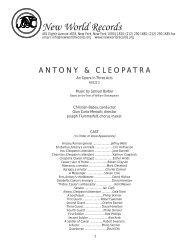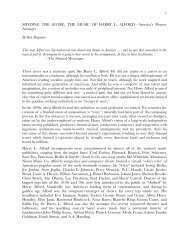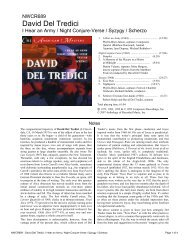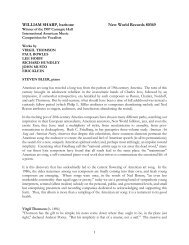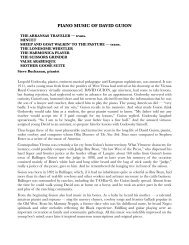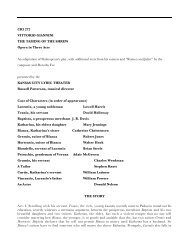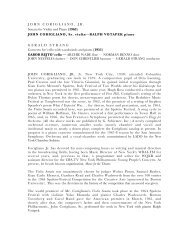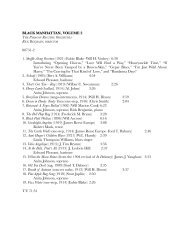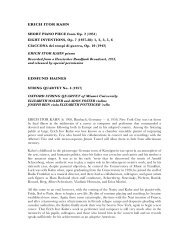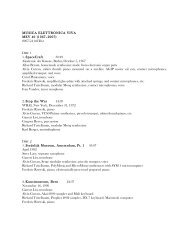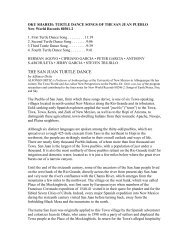"Indianist" Movement in American Music - New World Records
"Indianist" Movement in American Music - New World Records
"Indianist" Movement in American Music - New World Records
Create successful ePaper yourself
Turn your PDF publications into a flip-book with our unique Google optimized e-Paper software.
BEACH, FOOTE, FARWELL, OREM <strong>New</strong> <strong>World</strong> <strong>Records</strong> 80542<br />
The "Indianist" <strong>Movement</strong> <strong>in</strong> <strong>American</strong> <strong>Music</strong><br />
by Gilbert Chase<br />
The "Indianist" movement <strong>in</strong> <strong>American</strong> musical composition that flourished from the 1880s to the<br />
1920s had its antecedents <strong>in</strong> n<strong>in</strong>eteenth-century Romanticism, with its cult of “the noble savage"<br />
nourished by such writers as Chateaubriand, James Fenimore Cooper, and Longfellow, whose<br />
Hiawatha was like a magnet for many musicians. On the stage, the famous actor Edw<strong>in</strong> Forrest<br />
starred <strong>in</strong> the drama Metamora (1828) as "the noble Indian chief," who leads his warriors <strong>in</strong> a<br />
desperate struggle for freedom—"Our Lands! Our Nation's Freedom!—Or the Grave."<br />
Romantic writers tended to identify the Indian with the grandeur of Nature. Chateaubriand, a<br />
Frenchman, <strong>in</strong> his novel of the "noble savage" Atala gushed on "the soul's delight to lose itself<br />
amidst the wild sublimities of Nature." Such writers often lost their heads but seldom risked their<br />
lives. The <strong>American</strong> wilderness, viewed as untamed, primitive, exotic, lured not only explorers and<br />
adventurers hut also scientists, artists, poets, novelists—and at least one musician who came to<br />
know at first hand "the magnificent wilds of Kentucky" about which Chateaubriand rhapsodized.<br />
This venturesome musician was Anthony Philip He<strong>in</strong>rich (1781–1861), a native of Bohemia who<br />
emigrated to America <strong>in</strong> 1810. From 1817 to 1823 he lived <strong>in</strong> and around Lex<strong>in</strong>gton, Kentucky,<br />
call<strong>in</strong>g himself "the Wildwood Troubador." Accord<strong>in</strong>g to a contemporary account:<br />
He<strong>in</strong>rich passed several years of his life among the Indians that once <strong>in</strong>habited<br />
Kentucky, and many of his compositions refer to these aborig<strong>in</strong>al companions. He is<br />
a species of musical Catl<strong>in</strong>, pa<strong>in</strong>t<strong>in</strong>g his dusky friends on the music staff <strong>in</strong>stead of<br />
on the canvas, and compos<strong>in</strong>g laments, symphonies, dirges, and on the most<br />
<strong>in</strong>tensely Indian subjects. He would be the very one to set Hiawatha to music.<br />
Although He<strong>in</strong>rich chose to ignore the h<strong>in</strong>t about Hiawatha by 1858 (when the quoted article<br />
appeared) he had <strong>in</strong>deed earned the right to be regarded as a musical counterpart of the artistethnologist<br />
George Catl<strong>in</strong> (1796–1872), whose Letters and Notes on the Manners, Customs, and Condition<br />
of the North <strong>American</strong> Indians was published <strong>in</strong> 1841. He<strong>in</strong>rich may well have known this work, as well<br />
as Henry R. Schoolcraft's The Indian <strong>in</strong> His Wigwam, or Characteristics of the Red Race of America (1848).<br />
We know that he did read John McIntosh's The Orig<strong>in</strong> of the <strong>American</strong> Indians (1843), from which he<br />
quotes <strong>in</strong> the headnotes to several of his scores, notably the orchestral fantasia Pushmataha, A<br />
Venerable Chief of a Western Tribe. This work has been described as "probably the first attempt <strong>in</strong> all<br />
history to treat <strong>in</strong> music, <strong>in</strong> any adequate manner, the idea of the <strong>American</strong> Indian" (William Treat<br />
Upton).<br />
The key word here is idea. Unlike the later Indianist composers, He<strong>in</strong>rich did not actually use (or<br />
misuse) Indian musical themes. He was essentially an imag<strong>in</strong>ative composer, stirred by the tragic<br />
grandeur of the Indian race. He was especially affected by the forced removal of the Indians from<br />
their own lands, which occurred <strong>in</strong> his lifetime dur<strong>in</strong>g the adm<strong>in</strong>istration of Andrew Jackson. In all,<br />
He<strong>in</strong>rich composed eight large orchestral works on Indian subjects, plus several pieces for piano and<br />
for voice with piano. On his death his music—often oddly orig<strong>in</strong>al and bizarre <strong>in</strong> style—quickly fell<br />
<strong>in</strong>to oblivion (there has been a recent revival of <strong>in</strong>terest). Hence there is no cont<strong>in</strong>uity between him<br />
and the later Indianist movement. Furthermore, between the time of his death and the later<br />
1
development, significant changes had occurred both <strong>in</strong> the situation of the Indian tribes and <strong>in</strong><br />
<strong>American</strong> culture as a whole.<br />
The rise of ethnology and folklore studies <strong>in</strong> the second half of the n<strong>in</strong>eteenth century contributed<br />
greatly to our knowledge of <strong>American</strong> Indian cultures. When the <strong>American</strong> Folklore Society was<br />
founded <strong>in</strong> 1888, its stated purpose was "the collect<strong>in</strong>g of the fast-vanish<strong>in</strong>g rema<strong>in</strong>s of Folk-Lore <strong>in</strong><br />
America"—<strong>in</strong> particular that of the Indians and the Negroes. The notion that folklore was rapidly<br />
"vanish<strong>in</strong>g" was a shibboleth of that period. At least it stimulated the systematic collection and<br />
preservation of these presumably “fast-vanish<strong>in</strong>g rema<strong>in</strong>s.” As the Indians had been settled <strong>in</strong><br />
reservations, the task of notat<strong>in</strong>g their songs, dances, and ceremonies was considerably facilitated.<br />
In 1880 the <strong>American</strong> musical scholar and lexicographer Theodore Baker transcribed some harvest<br />
songs of the Iroquois as well as songs from the Cheyenne, Comanche, Dakota, Iowa, Kiowa, and<br />
Ponca tribes—a task he was able to accomplish conveniently because of a meet<strong>in</strong>g of tribal chiefs<br />
organized by the Indian Office of the Federal Government. Two years later he published these and<br />
other Indian melodies <strong>in</strong> his doctoral dissertation at the University of Leipzig (it was <strong>in</strong> German and<br />
has never been translated <strong>in</strong>to English). When Edward MacDowell decided to write an orchestral<br />
work us<strong>in</strong>g Indian themes, he took these from Baker's dissertation. The result was his Second<br />
(Indian) Suite, Op. 48 (1894), which rema<strong>in</strong>s one of his most frequently performed works.<br />
MacDowell was by no means a dedicated Indianist. He once said, "I do not believe <strong>in</strong> ‘lift<strong>in</strong>g’ a<br />
Navajo theme and furbish<strong>in</strong>g it <strong>in</strong>to some k<strong>in</strong>d of musical composition and call<strong>in</strong>g it <strong>American</strong><br />
music. Our problem is not so simple as that." The "problem" to which he referred was that of<br />
establish<strong>in</strong>g a national identity <strong>in</strong> <strong>American</strong> musical composition.<br />
This issue had been brought to a head by the arrival <strong>in</strong> <strong>New</strong> York of the famous composer Anton<strong>in</strong><br />
Dvorák, who, like He<strong>in</strong>rich, was a native of Bohemia. He spent from 1892 to 1895 <strong>in</strong> the United<br />
States, teach<strong>in</strong>g, compos<strong>in</strong>g, and express<strong>in</strong>g his ideas on how <strong>American</strong> composers should go about<br />
creat<strong>in</strong>g an <strong>American</strong> "national" music. Although he declared that the "Negro" melodies provided<br />
"all that is needed for a great and noble school of music" (a statement that <strong>in</strong>furiated MacDowell),<br />
he also gave some attention to Indian music. He became superficially acqua<strong>in</strong>ted with the latter, as is<br />
reflected <strong>in</strong> the Qu<strong>in</strong>tet Op. 97, dur<strong>in</strong>g a stay <strong>in</strong> Iowa. But his <strong>in</strong>fluence was ma<strong>in</strong>ly <strong>in</strong> the challenge<br />
he put to <strong>American</strong> composers: Stop imitat<strong>in</strong>g European models and turn to your native sources.<br />
If one took the term native literally, <strong>in</strong> the sense of <strong>in</strong>digenous, that would logically lead to the Indian<br />
trail. When the composer Frederick R. Burton declared that he was search<strong>in</strong>g for music "that is truly<br />
and wholly <strong>in</strong>digenous to our soil," he stated the Indianist motivation <strong>in</strong> its most <strong>in</strong>tense form. But<br />
his quest proved to be illusory. After transcrib<strong>in</strong>g some Ojibway melodies he transformed them <strong>in</strong>to<br />
such picturesquely superficial art songs as "My Bark Canoe" and "The Lake Sheen." These were<br />
"truly and wholly <strong>in</strong>digenous" only to the genteel tradition of the turn-of-the-century decorative<br />
picture postcard.<br />
From 1890 to 1910 many books on Indian lore and music were published. Francis La Flesche, an<br />
Omaha Indian, collaborated with Alice C. Fletcher <strong>in</strong> A Study of Omaha Indian <strong>Music</strong> (1893), while<br />
Fletcher herself brought out Indian Story and Song from North America (1900), with melodies<br />
harmonized by the composer John Comfort Fillmore. Natalie Curtis, who worked mostly among the<br />
Hopis and Zuñis, published The Indians' Book <strong>in</strong> 1907, and Frederick Burton's <strong>American</strong> Primitive <strong>Music</strong><br />
appeared <strong>in</strong> 1909. Ethnologists such as J. Walter Fewkes, Benjam<strong>in</strong> Ives Gilman (Hopi Songs, 1908),<br />
and Frances Densmore undertook a more "scientific" study of Indian music, with transcriptions and<br />
2
analyses. Fewkes was the first to use the phonograph for record<strong>in</strong>g Indian music and speech, among<br />
the Passamaquoddy of Ma<strong>in</strong>e <strong>in</strong> the w<strong>in</strong>ter of 1889–90. Densmore, work<strong>in</strong>g from 1907 under the<br />
auspices of the Bureau of <strong>American</strong> Ethnology, produced the largest body of work <strong>in</strong> this field. For<br />
example, her two monographs on Chippewa music (1910 and 1913) conta<strong>in</strong> a total of 340 songs—<br />
the largest collection ever published from one tribe.<br />
Among the composers who became <strong>in</strong>terested <strong>in</strong> the music of the Indians, some simply lifted their<br />
themes from the available publications, while others went to the reservations and did their own<br />
notations. A pioneer among the latter was Carlos Troyer (1837–1920), who worked ma<strong>in</strong>ly among<br />
the tribes of the Southwest. In his "Ghost Dance of the Zuñis," "Kiowa-Apache War-Dance" (both<br />
for piano), and Traditional Songs of the Zuñis (1904), for voice and piano, his aim was to be as<br />
"authentic" as possible.<br />
Harvey Worth<strong>in</strong>gton Loomis (1885–1930), who had studied with Dvořák <strong>in</strong> <strong>New</strong> York used<br />
Fletcher's transcriptions of Omaha themes for his Lyrics of the Red-Man (1903–4), for piano. Less<br />
concerned with authenticity, he aimed rather at artistic "fram<strong>in</strong>g." Charles Sanford Skilton (1888–<br />
1941), a <strong>New</strong> Englander educated at Yale and musically tra<strong>in</strong>ed <strong>in</strong> Berl<strong>in</strong>, became <strong>in</strong>terested <strong>in</strong><br />
Indian music when he went to teach at the University of Kansas and heard Indian students at the<br />
nearby Haskell Institute s<strong>in</strong>g tribal melodies. More than any other Indianist composer, he established<br />
the stereotypes of the genre with such works as "Deer Dance" and "War Dance," from the Suite<br />
Primeval for orchestra (based on songs of the W<strong>in</strong>nebago, Sioux, and Rogue River tribes).<br />
The Indianist movement also produced a slew of operas, from Arthur Nev<strong>in</strong>'s Poia (1909) and<br />
Victor Herbert's Natoma (1911) to Alberto Bimboni's W<strong>in</strong>ona (1926); Charles Wakefield Cadman's<br />
Shanewis (1918) was the only notable success of the lot. Grand opera and Indian culture were poles<br />
apart.<br />
Above all it was a voice and a spirit from the Midwest, <strong>in</strong> the person of Arthur Farwell (1872–1952),<br />
that gave deep and endur<strong>in</strong>g significance to the Indianist movement. Not that his vision was<br />
conf<strong>in</strong>ed only to that aspect of America's musical heritage—he took a "broad and all-embrac<strong>in</strong>g<br />
view" of the "realities and possibilities of <strong>American</strong> musical life." In tak<strong>in</strong>g up Dvořák's challenge to<br />
<strong>American</strong> composers to create a truly "national" music, he proposed a pluralistic approach that<br />
would <strong>in</strong>clude "notably, ragtime, Negro songs, Indian songs, Cowboy songs, and, of the utmost<br />
importance, new and dar<strong>in</strong>g expressions of our own composers, sound-speech previously unheard."<br />
Yet there is no doubt that with<strong>in</strong> this broadly humanistic prospect he had a particular aff<strong>in</strong>ity with<br />
<strong>American</strong> Indian lore.<br />
Farwell was born <strong>in</strong> St. Paul, M<strong>in</strong>nesota. As a youth he showed musical aptitude but with no strong<br />
vocational urge. Parental expectations led him to enroll at the Massachusetts Institute of<br />
Technology, major<strong>in</strong>g <strong>in</strong> electrical eng<strong>in</strong>eer<strong>in</strong>g. What really turned him on to music were the<br />
concerts of the Boston Symphony. By the time he got his degree, he knew that music would be his<br />
life's work. After several years of musical study <strong>in</strong> Boston, Germany, and Paris he returned to the<br />
United States <strong>in</strong> 1899 and thenceforth devoted himself to a highly active, varied, and productive<br />
musical career that took him throughout most of the nation, from <strong>New</strong> York to California. His first<br />
important enterprise was the found<strong>in</strong>g of the Wa-Wan Press—named after a tribal ceremony of the<br />
Omahas—<strong>in</strong> 1901. Its ma<strong>in</strong> purpose was to publish the work of younger <strong>American</strong> composers,<br />
<strong>in</strong>clud<strong>in</strong>g himself, <strong>in</strong> whom the established publishers showed little or no <strong>in</strong>terest. Volumes were<br />
issued periodically until 1911. They <strong>in</strong>cluded most of Farwell's Indian pieces, as well as the Indianist<br />
3
works of Troyer and Loomis previously mentioned. These were usually preceded by explanatory<br />
essays describ<strong>in</strong>g the relation of the music to Indian tribal lore. They also reveal Farwell's deep<br />
aff<strong>in</strong>ity for and identification with the underly<strong>in</strong>g symbols and values of Indian life. He had a strong<br />
feel<strong>in</strong>g for nature, and his favorite spot for compos<strong>in</strong>g was a forest hideaway <strong>in</strong> view of the Teton<br />
range.<br />
For many of his Indian themes Farwell relied on the melodies transcribed by Alice Fletcher; but <strong>in</strong><br />
other <strong>in</strong>stances he made his own transcriptions, <strong>in</strong>clud<strong>in</strong>g some from phonograph record<strong>in</strong>gs. He<br />
visited a number of reservations, particularly <strong>in</strong> the Southwest. Most of his Indian pieces were<br />
composed from 1899 to 1908; later exceptions <strong>in</strong>clude a str<strong>in</strong>g quartet (The Hako; 1922) and some<br />
choral arrangements.<br />
For Farwell, Indian music was neither an exotic novelty nor an <strong>in</strong>gredient of "native <strong>American</strong>ism"<br />
but rather a profound and primeval source of <strong>in</strong>spiration. He saw it as an "<strong>in</strong>nate force" by which<br />
we are carried "<strong>in</strong>to a new world of mean<strong>in</strong>gs." The Indian melodies, he ma<strong>in</strong>ta<strong>in</strong>ed, are "not <strong>in</strong> the<br />
realm of what is commonly regarded as Art, but only <strong>in</strong> that which we understand by the term<br />
Religion. Song, an <strong>in</strong>visible agent, is to the Indian the direct means of communicat<strong>in</strong>g with his<br />
<strong>in</strong>visible god."<br />
PRESTON WARE OREM<br />
<strong>American</strong> Indian Rhapsody<br />
Preston Ware Orem (1865–1938) was born <strong>in</strong> Philadelphia, where for most of his life he was active<br />
as a teacher, organist, composer, and (from 1900) editor for the music publisher Theodore Presser.<br />
From 1889 to 1895 he was organist at St. Paul's Procathedral <strong>in</strong> Los Angeles. Like MacDowell's, his<br />
<strong>in</strong>terest <strong>in</strong> <strong>American</strong> Indian music was casual—and much more superficial. But Indianism was <strong>in</strong><br />
fashion, and this no doubt attracted him. His <strong>American</strong> Indian Rhapsody for piano (also orchestrated),<br />
published by Presser <strong>in</strong> 1918, manipulates themes "recorded and suggested" by Thurlow Lieurance<br />
(1878–1963), a composer who spent many years collect<strong>in</strong>g Indian melodies and earned a small<br />
measure of immortality by adapt<strong>in</strong>g one of these for a song that he called "By the Waters of<br />
M<strong>in</strong>netonka."<br />
Orem's Rhapsody is very much a period piece, stylistically conventional and eclectic, post-Romantic<br />
and neo-Lisztian <strong>in</strong> its mannerisms and pretentiousness, its plethora of trills, arpeggios, broken<br />
chords, and repeated octaves (often thunderous), and its bravura display of virtuosity, with<br />
<strong>in</strong>dications rang<strong>in</strong>g from molto maestoso to allegretto scherzando, from andante affetuoso to allegro con brio<br />
from amabile to feroce (the savage!). It is probably the most far-out Indianist composition ever written.<br />
ARTHUR FARWELL<br />
The Old Man's Love Song, Op. 102, No.2<br />
Navajo War Dance, Op. 102, No.1<br />
In 1937 Farwell made arrangements for unaccompanied chorus of the “Navajo War Dance,”<br />
"Pawnee Horses," "The Old Man's Love Song," and "The Mother's Vow" (this last from the orig<strong>in</strong>al<br />
<strong>American</strong> Indian Melodies of 1900). He also made another choral version of "Navajo War Dance"<br />
(No.2) <strong>in</strong> 1947, for a concert tour by the Westm<strong>in</strong>ster Choir directed by John F<strong>in</strong>ley Williamson.<br />
Concern<strong>in</strong>g this, Farwell wrote:<br />
4
This chorus is so notated as to br<strong>in</strong>g out the <strong>in</strong>ner pulsations of the Indian voice, as<br />
observed <strong>in</strong> the Indians' s<strong>in</strong>g<strong>in</strong>g of songs of this type <strong>in</strong> the Southwest. In ord<strong>in</strong>ary<br />
notation, the first measure, for example, would be written as four quarter-notes; but<br />
if sung so, would be very remote from the effect of the Indians' s<strong>in</strong>g<strong>in</strong>g. The<br />
measure will <strong>in</strong>deed present four major pulses, but each will be followed by a<br />
secondary eighth-note pulse of lesser accentuation.<br />
In "The Old Man's Love Song" and "Navajo War Dance," Farwell went far beyond any other<br />
Indianist composer <strong>in</strong> achiev<strong>in</strong>g what may perhaps be best described as "creative authenticity."<br />
Navajo War Dance, for piano<br />
Concern<strong>in</strong>g this piece, Farwell wrote:<br />
Too many people th<strong>in</strong>k of the <strong>American</strong> Indian only as a "savage." I had <strong>in</strong> my<br />
Indian music depicted many phases of Indian life that were far from savage, but true<br />
to its qua<strong>in</strong>t, poetic and picturesque aspects, as well as to its mythological<br />
conceptions. Be<strong>in</strong>g criticized because of these matters, as be<strong>in</strong>g untrue to this<br />
"savage" Indian nature, I wrote the Navajo War Dance <strong>in</strong> the hope of gratify<strong>in</strong>g my<br />
critics <strong>in</strong> this respect. . . . I have employed bare 4ths considerably <strong>in</strong> this work, as I<br />
have heard the Navajos s<strong>in</strong>g this war dance <strong>in</strong> 4ths.<br />
In l<strong>in</strong>e with this aim, Farwell directs that the piece should be played "with severe precision of<br />
rhythm throughout, and savagely accented." After a brief <strong>in</strong>troduction <strong>in</strong> 9/8, the music cont<strong>in</strong>ues <strong>in</strong><br />
6/8 to the end. For ears accustomed to the "barbaric" rhythms of Bartók and Strav<strong>in</strong>sky, this will<br />
seem more impressive for its f<strong>in</strong>ely controlled artistry than for its "savagery." It was the first of<br />
Farwell's compositions to be widely performed and acclaimed.<br />
Pawnee Horses, for piano<br />
This piece, like the "Navajo War Dance," was <strong>in</strong>cluded <strong>in</strong> the set of pieces for piano titled From Mesa<br />
and Pla<strong>in</strong>, published by the Wa-Wan Press. A headnote tells us that it was "based on an Omaha<br />
melody sung by Francis La Flesche and transcribed by Edw<strong>in</strong> S. Tracy." The title page also carries a<br />
quotation that expla<strong>in</strong>s the context of the piece: "There go the Pawnee horses. I do not want<br />
them,—I have taken enough." Marked to be played "with motion," it ma<strong>in</strong>ta<strong>in</strong>s a consistently<br />
syncopated pattern throughout alternat<strong>in</strong>g between 9/8 and 6/8.<br />
Boston, Mrs. Gardner, Fenway Court, & <strong>Music</strong><br />
by Herbert A. Kenny<br />
On April 23, 1906, Fiorella, a comic opera with music by Amherst Webber, was mounted for the first<br />
time <strong>in</strong> Fenway Court, a Venetian palace overlook<strong>in</strong>g Muddy Brook <strong>in</strong> the Fenway section of<br />
Boston. The auditorium was the music room of the splendid museum Isabella Stewart Gardner had<br />
built as her f<strong>in</strong>al home and as a public <strong>in</strong>stitution. The cream of Boston society, which had once<br />
snubbed her, had vied for <strong>in</strong>vitations along with the <strong>in</strong>tellectual leaders of the community. The<br />
composer was a m<strong>in</strong>or figure who without Mrs. Gardner's help would not have seen his<br />
<strong>in</strong>consequential opera produced. "You are a magician," he wrote to her. Wilhelm Gericke,<br />
conductor of the Boston Symphony Orchestra, called her "the genius lady." The even<strong>in</strong>g was a<br />
triumph.<br />
5
Other auspicious performances had preceded Fiorella at Mrs. Gardner's, and others would follow.<br />
The next year, for example, the Boston Symphony played Charles Mart<strong>in</strong> Loeffler's Pagan Poem there.<br />
How could such musical even<strong>in</strong>gs occur <strong>in</strong> 1906 <strong>in</strong> any city <strong>in</strong> the United States—particularly<br />
Boston, where a hundred years earlier such performances were deemed immoral, and fifty years<br />
earlier any <strong>American</strong> composer of concert music was hard put to f<strong>in</strong>d a publisher, a group to<br />
perform his works, and an audience? Mrs. Gardner—Belle and sometimes Busy Ella to her wealthy<br />
husband, John Lowell Gardner, Jr.; Aunt Belle to three orphaned nephews; Dear Lady to a<br />
scandalous collection of young musicians and pa<strong>in</strong>ters; Isabella and various sobriquets to her<br />
<strong>in</strong>timates—was a woman of genius and Boston's most flamboyant patron of the arts. She got<br />
together <strong>in</strong> those golden years (before <strong>in</strong>come taxes) with two preem<strong>in</strong>ent men—Henry Lee<br />
Higg<strong>in</strong>son, like Mrs. Gardner a transplanted <strong>New</strong> Yorker, who created out of his own pocket the<br />
Boston Symphony and Symphony Hall, and John Knowles Pa<strong>in</strong>e, a composer and teacher, who<br />
would educate a generation of composers—and their impact, first felt <strong>in</strong> the 1880s, cont<strong>in</strong>ues today.<br />
The early-twentieth-century English writer G. K. Chesterton once said that every story should beg<strong>in</strong><br />
with Genesis. The Boston story does, for the Puritan fathers built on the Old Testament a narrow<br />
and stern society with no time or sympathy for the arts. At first, psalms could be sung <strong>in</strong><br />
meet<strong>in</strong>ghouses only by the unaccompanied congregation; soloists and musical <strong>in</strong>struments were not<br />
permitted. Even as the literary flower<strong>in</strong>g began, however, there was a musical quicken<strong>in</strong>g. The<br />
Unitarian revolt and the Transcendental movement began a happy release from the strictures of<br />
Puritanism. Choral groups came first, and Handel's Messiah made Protestant div<strong>in</strong>es comfortable <strong>in</strong><br />
the presence of soloists. The Stoughton <strong>Music</strong>al Society was founded as early as 1768 by Englishspeak<strong>in</strong>g<br />
America's first composer, William Bill<strong>in</strong>gs (1746–1800). In 1808 some Harvard students<br />
formed a musical group called the Pierian Sodality. Two years later Johann Christian Gottlieb<br />
Graupner, who had played the oboe <strong>in</strong> Haydn's orchestra, formed a musical group and gave some<br />
concerts. In 1815 he and some others formed the Handel and Haydn Society, which still prospers.<br />
In 1833 Lowell Mason (with G. J. Webb) opened the Boston Academy of <strong>Music</strong> and was<br />
<strong>in</strong>strumental <strong>in</strong> hav<strong>in</strong>g music taught <strong>in</strong> the public schools. In 1837 some Harvard graduates formed<br />
the Harvard <strong>Music</strong>al Association; when their appeal to Josiah Qu<strong>in</strong>cy, president of the college, to<br />
establish music courses failed, they undertook public lectures, then formed an orchestra, and later<br />
built the long-famous but now gone <strong>Music</strong> Hall.<br />
Early <strong>in</strong> the n<strong>in</strong>eteenth century Boston was a prov<strong>in</strong>cial town of eight thousand persons with no<br />
more than fifty pianos, which gave out noth<strong>in</strong>g but hymns and popular tunes. The sole musical<br />
<strong>in</strong>strument deemed suitable for a man was the flute, and musical groups were formed of massed<br />
flute players; the overture to Don Giovanni was even arranged for a flute band. In 1840 an orchestra<br />
formed by the Academy of <strong>Music</strong> was the first to play Beethoven symphonies. By 1844 the Harvard<br />
<strong>Music</strong>al Association <strong>in</strong>augurated some chamber-music <strong>in</strong>terludes and imported from Germany what<br />
proved the largest organ <strong>in</strong> America. Six months after the end of the Civil War, the Association's<br />
own orchestra of sixty-two players, some hired from local theaters, gave its first concert. The<br />
orchestra carried on for seventeen years until the formation of the Boston Symphony. In 1867 the<br />
<strong>New</strong> England Conservatory of <strong>Music</strong> was founded and John Knowles Pa<strong>in</strong>e began teach<strong>in</strong>g at<br />
Harvard. Hook and Hast<strong>in</strong>gs were build<strong>in</strong>g organs <strong>in</strong> the city, and Chicker<strong>in</strong>g was mak<strong>in</strong>g pianos.<br />
Foreign opera companies appeared occasionally <strong>in</strong> packed theaters. In 1872 came the <strong>World</strong> Peace<br />
Jubilee, for which the Irish-horn bandmaster Patrick Sarsfield Gilmore organized an extravaganza<br />
where a chorus of ten thousand sang, a thousand musicians sought to play together, and fifty<br />
6
firemen <strong>in</strong> red-white-and-blue uniforms pounded out the rhythm of the "Anvil Chorus" with real<br />
sledgehammers on real anvils.<br />
About this time Mrs. Jack Gardner bought her first major pa<strong>in</strong>t<strong>in</strong>g and began to collect writers,<br />
pa<strong>in</strong>ters, sculptors. and musicians. In 1852 she and her husband had moved <strong>in</strong>to 152 Beacon Street,<br />
where she would live for forty years and would attract a multitude of artists. In the days before Mrs.<br />
Gardner gave her musicales, musicians came and left by the servants’ entrance. For her they came as<br />
equals; her home, her purse, and her heart were open to them. The list of artists and celebrities she<br />
befriended or enterta<strong>in</strong>ed is enormous: Oliver Wendell Holmes, James Russell Lowell, Henry<br />
Adams, Henry James, F. Marion Crawford (a friendship and a flirtation that came close to tragic<br />
romance), Owen Wister, Charles Eliot Norton, John Sullivan Dwight, Arthur Foote, Edward<br />
MacDowell, Julia Ward Howe, Maude Howe Elliott and her pa<strong>in</strong>ter-husband Jack, Oscar Wilde,<br />
Clayton Johns, Nellie Melba, Lena Little, Wilhelm Gericke, Paul Manship, Joseph L<strong>in</strong>don Smith,<br />
Dennis Bunker, Charles Mart<strong>in</strong> Loeffler, John S<strong>in</strong>ger Sargent (whose pa<strong>in</strong>t<strong>in</strong>g of her shocked<br />
society), Anders Zorn (who was thought to have pa<strong>in</strong>ted her <strong>in</strong> the nude—he didn't), Ignace<br />
Paderewski, and on and on. She was host to whole opera casts, engaged the Boston Symphony for<br />
her pleasure (her motto was "C’est Mon Plaisir!"), attended prize-fights to the horror of the stuffy,<br />
drove lion cubs about <strong>in</strong> her carriage, had one more liveried footman than any other Bostonian,<br />
wore two walnut-size diamonds <strong>in</strong> her hair, hung her pearls around her waist rather than around her<br />
neck, and was the first to ditch the bustle ("Who undressed you?" one wag wanted to know; Mrs.<br />
Gardner named a Paris couturier and asked if he hadn't done it well) and wear her skirts above the<br />
ankle. She appeared at a Boston Symphony concert with a headband that read "Oh, you Red Sox!"<br />
and was <strong>in</strong> general delightfully unpredictable. She was also highly <strong>in</strong>tellectual, had exquisite, sure<br />
taste, and was deeply religious. A devout Anglican, on one occasion she did penance by wash<strong>in</strong>g the<br />
stone steps of the Church of the Advent (a well-publicized event). In key with her motto, she did as<br />
she pleased. Her husband adored and <strong>in</strong>dulged her and endured her <strong>in</strong>discretions, and the public<br />
loved her. (William Dean Howells, however, found her arrogant and was shocked at her treatment<br />
of the workmen build<strong>in</strong>g her palace. The period had its ugly side, which L<strong>in</strong>coln Steffens, Jacob Riis,<br />
Monsignor John A. Ryan, and the muckrakers were expos<strong>in</strong>g.) By the 1890s, Mrs. Jack Gardner was<br />
Boston's cultural arbiter.<br />
She was deemed frivolous by many and immoral by some. But she was a dutiful and dot<strong>in</strong>g foster<br />
mother to her three nephews (her only child had died <strong>in</strong> his <strong>in</strong>fancy). She was also a true<br />
bluestock<strong>in</strong>g and worked on her own education as she worked on theirs.<br />
Charles Eliot Norton's lectures on Dante had awakened her to the cultural life and turned her <strong>in</strong>to a<br />
relentless collector. Her love of art and music was genu<strong>in</strong>e and well ahead of her time. She began the<br />
construction of Fenway Court to house her art collection <strong>in</strong> 1899, n<strong>in</strong>e years before the present<br />
Museum of F<strong>in</strong>e Arts was built, and at the time she had the better collection.<br />
In 1900 Henry Lee Higg<strong>in</strong>son built Symphony Hall for the orchestra he had founded <strong>in</strong> 1881. In<br />
1902 the <strong>New</strong> England Conservatory moved to Hunt<strong>in</strong>gton Avenue very near Symphony Hall, and<br />
the younger Eben D. Jordan, son of the city's lead<strong>in</strong>g merchant, not to be outdone by Higg<strong>in</strong>son,<br />
built Jordan Hall adjo<strong>in</strong><strong>in</strong>g the Conservatory. In 1908 the Opera House was built across the street. It<br />
was a time of ferment.<br />
In 1875 Arthur Foote had received from Harvard his Master of Arts degree <strong>in</strong> music, the first such<br />
ever granted <strong>in</strong> the United States. In 1884 he published his first song, dedicated to the s<strong>in</strong>ger Lillian<br />
Bailey, the wife of George (later Sir George) Henschel, the first conductor of the Boston Symphony.<br />
7
Foote was only one of Pa<strong>in</strong>e's many students to become a successful composer. Some others were<br />
John Alden Carpenter, Frederick Converse, Clayton Johns, and Daniel Gregory Mason. But there<br />
were also many composers <strong>in</strong> the "Boston group" aside from Pa<strong>in</strong>e's students, <strong>in</strong>clud<strong>in</strong>g Charles<br />
Mart<strong>in</strong> Loeffler, W. Eugene Thayer, Ethelbert Nev<strong>in</strong>, Margaret Ruthven Lang, Amy Beach, and<br />
Edward MacDowell, the most dist<strong>in</strong>guished. Many were church organists (Foote for more than<br />
three decades), and most taught; none received abundant performance. In 1895 Anton<strong>in</strong> Dvořák<br />
wrote <strong>in</strong> Harper's <strong>New</strong> Monthly:<br />
When I see how much is done <strong>in</strong> every other field by public spirited men <strong>in</strong><br />
America—how schools, universities, libraries, museums and hospitals and parks<br />
spr<strong>in</strong>g up out of the ground and are ma<strong>in</strong>ta<strong>in</strong>ed by generous gifts—I can only<br />
marvel that so little has been done for music.<br />
He specifically mentioned "the superb orchestra supported by a public citizen of Boston” as<br />
an example of what can he done.<br />
Even <strong>in</strong> 1900 the <strong>American</strong> composer's lot was difficult. Orchestras and audiences preferred the<br />
Europeans. The Boston Symphony was just about as generous to local composers as it is today.<br />
Perhaps the rapid turnover of conductors had someth<strong>in</strong>g to do with it: Henschel, 1881–84; Gericke,<br />
1884–89; Arthur Nikisch, 1889–93; Emil Paur, 1893–98; Gericke aga<strong>in</strong>, 1898–1906; Karl Muck,<br />
1906–08; Max Fiedler, 1908–12; and then Muck aga<strong>in</strong>, 1912–18.<br />
Mrs. Gardner befriended them all. When anti-German sentiments caused Muck to be jailed dur<strong>in</strong>g<br />
<strong>World</strong> War I and then deported, she stood by him and received acrimony and calumny by<br />
champion<strong>in</strong>g him aga<strong>in</strong>st superpatriots. She lived through three wars and hated them all; the Civil<br />
War, <strong>in</strong> which her husband and his family and friends sympathized with the South; the Spanish-<br />
<strong>American</strong> War; and <strong>World</strong> War I, dur<strong>in</strong>g which, despite her antiwar feel<strong>in</strong>gs, she raised money for<br />
the charitable efforts of the Knights of Columbus.<br />
Throughout the eighties and n<strong>in</strong>eties and the open<strong>in</strong>g years of the new century Mrs. Gardner<br />
engaged musical groups to perform and composers to play their own works. One of the most<br />
popular units at the time was the Kneisel Quartet. In 1888 Edward MacDowell had performed his<br />
own music with this group and with the Boston Symphony before leav<strong>in</strong>g for <strong>New</strong> York to become<br />
the first professor of music at Columbia University. Also important for composers at the time was<br />
the arrival <strong>in</strong> Boston of Arthur P. Schmidt to publish their works. It was he who published Pa<strong>in</strong>e's<br />
Spr<strong>in</strong>g Symphony and many works by Foote, Beach, MacDowell, Chadwick, B. J. Lang, Henry<br />
Hadley, and others.<br />
The social meet<strong>in</strong>gs between composers and conductors at Mrs. Gardner's Beacon Street home and<br />
her other houses no doubt led to more <strong>American</strong> music be<strong>in</strong>g played than would otherwise have<br />
been the case. The all-male St. Botolph Club was another gather<strong>in</strong>g place.<br />
Often composers would conduct their own works with the Boston Symphony. Foote was to play the<br />
piano with the orchestra eleven times <strong>in</strong> performances of his own work. In 1890 he dedicated his<br />
Viol<strong>in</strong> Sonata to Franz Kneisel, the orchestra's concertmaster and leader of the Kneisel Quartet, as<br />
an appreciation. The next year Foote wrote his Quartet for Piano and Str<strong>in</strong>gs <strong>in</strong> C major while<br />
stay<strong>in</strong>g at the Alhambra, Mrs. Gardner's summer cottage <strong>in</strong> Prides Cross<strong>in</strong>g on Massachusetts Bay.<br />
8
When her musicales outgrew the music room at 152 Beacon Street she had her husband buy the<br />
adjo<strong>in</strong><strong>in</strong>g house, build a larger music room <strong>in</strong> it, and jo<strong>in</strong> the houses together. <strong>Music</strong>ians loved to<br />
play there. Clayton Johns, whom she befriended for years (she never turned her back on friends or<br />
protégés even if they never fulfilled their promise), was desperately shy and hated play<strong>in</strong>g <strong>in</strong> public<br />
except before twenty-five or thirty guests <strong>in</strong> the Gardners' music room or a smaller group <strong>in</strong> Venice<br />
at the Palazzo Barbaro, which for a while Mrs. Gardner rented annually. In his Rem<strong>in</strong>iscences (see<br />
Bibliography) Johns wrote:<br />
Mrs. Gardner wish<strong>in</strong>g to be <strong>in</strong>dividual as she wished always to be <strong>in</strong>dividual <strong>in</strong><br />
everyth<strong>in</strong>g she did, engaged Paderewski to play a recital for herself alone at her<br />
house at 152 Beacon Street. Before the recital, Mrs. Gardner, out of the k<strong>in</strong>dness<br />
of her heart, smuggled me <strong>in</strong>to an adjo<strong>in</strong><strong>in</strong>g room where I sat and listened beh<strong>in</strong>d<br />
the tapestries. After the music was over, I was <strong>in</strong>vited to jo<strong>in</strong> the supper party<br />
which was composed of Mr. and Mrs. Gardner, Paderewski and myself.<br />
When Fenway Court was built, 152 Beacon Street was torn down. To this day there is no 152<br />
Beacon Street, just as there could not be another Mrs. Gardner.<br />
Fenway Court had its dedicatory concert on <strong>New</strong> Year's night, 1903, with fifty musicians play<strong>in</strong>g<br />
under Gericke. The weather was freez<strong>in</strong>g, and, because of a railroad strike that had stopped coal<br />
shipments, the palace was heated only by wood stoves and hearth fires. Mrs. Gardner, radiant, her<br />
diamonds flash<strong>in</strong>g aga<strong>in</strong>st her hair, stood exalted on a platform where two flights of stairs jo<strong>in</strong>ed at<br />
one end of the music room. Guests walked up one flight to greet her and went down the other.<br />
Some sniffed at the apparent homage she was demand<strong>in</strong>g, but most were <strong>in</strong>different or amused and<br />
marched dutifully up and down. Dur<strong>in</strong>g the concert she sat alone on the balcony. Gericke<br />
conducted Bach, Mozart, Chausson, and Schumann. Lena Little sang. After the concert the doors to<br />
the great courtyard were flung open and the more than a hundred and fifty guests were admitted to<br />
gasp at the beauty of the palace. Mrs. Gardner served two of her favorites, champagne and<br />
doughnuts. There was other food, but Edith Wharton denigrated the champagne and doughnuts <strong>in</strong><br />
an aside <strong>in</strong> French that Mrs. Gardner caught. On Edith's departure Isabella told her off. There was<br />
never any question about her temper. The even<strong>in</strong>g, however, was a great success. William Apthorp<br />
glowed about it <strong>in</strong> an article <strong>in</strong> the Boston Even<strong>in</strong>g Transcript. Charles Eliot Norton gushed <strong>in</strong> a letter<br />
to his hostess. The sett<strong>in</strong>g was <strong>in</strong>comparable, and the even<strong>in</strong>g was not surpassed until the night<br />
Nellie Melba sang magnificently from a balcony above the courtyard with its founta<strong>in</strong> and flowers.<br />
Isabella gave her a large diamond.<br />
None of Mrs. Gardner's composer friends’ music was played on the open<strong>in</strong>g night, but she had not<br />
forgotten them or her other artist protégés. From then on the palace was alive with them. Loeffler<br />
was given a room of his own to compose <strong>in</strong> when he wanted and Sargent lived <strong>in</strong> Fenway Court<br />
while pa<strong>in</strong>t<strong>in</strong>g Mrs. Fiske Warren and others. Their letters to her were ador<strong>in</strong>g; they all recognized a<br />
debt.<br />
Two of the greatest critics <strong>in</strong> Boston <strong>in</strong> those years were Philip Hale and H. T. Parker. Hale was<br />
scholarly, Parker creative. Hale wrote for the Boston Herald, Parker for the Transcript. Mrs. Gardner<br />
knew them both well.<br />
Perhaps the age was too imitative of Europe, too detached from ragtime, jazz, Negro spirituals, and<br />
9
the folk songs Dvořák so admired; but it was not <strong>in</strong>expert or stale. Foote has been played by the<br />
BSO s<strong>in</strong>ce his death, and Amy Beach's songs are still sung. S<strong>in</strong>ce <strong>World</strong> War II there has been ris<strong>in</strong>g<br />
curiosity about her, Helen Hopekirk (the Scottish composer and pianist who settled <strong>in</strong> Boston), and<br />
Margaret Ruthven Lang. Mrs. Gardner's dom<strong>in</strong>ance of the city's cultural life did not harm the career<br />
of any woman <strong>in</strong> Boston at the time. Among her dear friends were Julia Ward Howe, her daughter<br />
Maude Howe Elliott, Nellie Melba, and Lena Little.<br />
Mrs. Gardner was generous to cultural competitors, and no one helped Higg<strong>in</strong>son more <strong>in</strong><br />
assembl<strong>in</strong>g the Boston Symphony and construct<strong>in</strong>g Symphony Hall. When he <strong>in</strong>sisted that it was<br />
necessary to go abroad for competent musicians, there was acrimonious dissent. For all her devotion<br />
to young <strong>American</strong>s, Mrs. Gardner sided with him. Quality was always her aim. While the hall was<br />
be<strong>in</strong>g built she <strong>in</strong>spected it with him, and she asked his advice on the construction of the music<br />
room <strong>in</strong> her palace. When tickets were auctioned for the grand open<strong>in</strong>g of Symphony Hall, the<br />
highest bid was a sensational $1,120 for two $12 season tickets by an agent for an unnamed client.<br />
At the open<strong>in</strong>g those seats became the cynosure of excited eyes. The bidder, of course, was Mrs.<br />
Gardner (she was attended by George Proctor, who was more or less her pianist <strong>in</strong> residence), and<br />
she almost stole the show from the magnificence of the hall. She rarely missed a performance, and<br />
<strong>in</strong>deed Gericke would not raise his baton until he saw she was seated, When the trustees of the<br />
Museum of F<strong>in</strong>e Arts began their new build<strong>in</strong>g, they sought her advice. Her husband, who had died<br />
<strong>in</strong> 1898, had left her his fortune <strong>in</strong> trust, and money was not as plentiful for her as it had been. No<br />
longer could she afford to have the entire company of the San Carlo Opera to d<strong>in</strong>ner, and on trips<br />
to Venice she st<strong>in</strong>ted. Nevertheless, after <strong>World</strong> War I she sent her needy musician friends abroad<br />
gifts and money.<br />
Long before Mrs. Gardner moved to Fenway Court, Bernard Berenson was act<strong>in</strong>g as her agent and<br />
buy<strong>in</strong>g pictures <strong>in</strong> Italy. Pa<strong>in</strong>t<strong>in</strong>g began to replace music as her first love. In 1914 she made two<br />
rooms of the exquisite music room, chiefly to give Sargent's pa<strong>in</strong>t<strong>in</strong>g El Jaleo the perfect sett<strong>in</strong>g.<br />
When T. Jefferson Coolidge, who owned the pa<strong>in</strong>t<strong>in</strong>g and had promised to give it to her sometime,<br />
saw what she had accomplished, he gave it to her directly. It portrays a Spanish gypsy dancer<br />
accompanied by two guitarists and a clapp<strong>in</strong>g caballero. The dancer might well symbolize Mrs.<br />
Gardner's beauty and abandon and enchantment with be<strong>in</strong>g alive. She had long before determ<strong>in</strong>ed<br />
that others might build hospitals and orphanages; she wanted to create someth<strong>in</strong>g beautiful. She did.<br />
The Isabella Stewart Gardner Museum is only part of her magnificent memorial. The vanished<br />
musical sounds of that era, the scores that rema<strong>in</strong>, the names and memories are the rest of it. When<br />
her young composers are played so many years later, we must try to hear her as well.<br />
AMY MARCY BEACH<br />
Sonata for Piano and Viol<strong>in</strong> <strong>in</strong> A m<strong>in</strong>or, Op. 34<br />
Amy Marcy Beach (1867–1944) was the preem<strong>in</strong>ent woman composer of her day, but before her<br />
death her music, except for some songs that have never lost their popularity, was disda<strong>in</strong>ed by the<br />
anti-Edwardian reaction. Yet the renewal of <strong>in</strong>terest <strong>in</strong> her music preceded the nostalgic revivals of<br />
the 1970s. By 1974 the Beach revival had grown to the po<strong>in</strong>t that record<strong>in</strong>gs were made of sixteen<br />
piano pieces and the Str<strong>in</strong>g Quartet <strong>in</strong> F-sharp m<strong>in</strong>or. The piano pieces were hailed by critics as<br />
graceful, tuneful, and technically brilliant, and the Qu<strong>in</strong>tet was praised for its <strong>in</strong>tegrity and style and<br />
favorably compared with the chamber works of Brahms.<br />
In her day it was said that Amy Marcy Beach wrote like a man, an observation that would not sit<br />
10
well with today's fem<strong>in</strong>ists. What was meant, at a time when few women were compos<strong>in</strong>g, was that<br />
she wrote very well <strong>in</strong>deed, took on the larger forms, and demonstrated a tough-m<strong>in</strong>ded energy <strong>in</strong><br />
her works. Many critics today prefer her to Foote (although he was deemed her superior <strong>in</strong> his day),<br />
which may <strong>in</strong>dicate that she wrote better than a man—better, certa<strong>in</strong>ly, than some of her male<br />
contemporaries.<br />
The Sonata for Piano and Viol<strong>in</strong> <strong>in</strong> A m<strong>in</strong>or, Op. 34, is one of Beach's masterworks. Some consider<br />
it better than her Gaelic Symphony, her Qu<strong>in</strong>tet, or her piano concertos. She composed it <strong>in</strong> six<br />
weeks <strong>in</strong> 1896, after complet<strong>in</strong>g her Gaelic Symphony. In January of the next year she performed it<br />
for the first time with Franz Kneisel.<br />
The piece thoroughly reflects Beach's dist<strong>in</strong>ctive musical personality and technical mastery. Her<br />
modes of development are common to classic composers, but her sure success <strong>in</strong> handl<strong>in</strong>g such<br />
strictly logical methods spr<strong>in</strong>gs from her own musical convictions. The melodies show the rugged<br />
strength we frequently encounter <strong>in</strong> Brahms, but Beach has her own profundities.<br />
The contrast<strong>in</strong>g themes, muscular and melodious, are skillfully manipulated <strong>in</strong>to a solid structural<br />
design. The harmonies are rich, and keys and chords change and merge with flexibility. The<br />
contrapuntal texture is as admirable as the general tone, from the stately open<strong>in</strong>g theme through the<br />
spirited Scherzo, the Largo, and the close. Yet there is a storm and stress that may betray her youth<br />
or the dispatch with which the piece was written.<br />
Each movement has its own themes, each theme its key. But formal as the Sonata is, it has its<br />
surprises. In the Scherzo the più lento eruption, with its change of key and meter, has an ost<strong>in</strong>ato<br />
<strong>in</strong> the viol<strong>in</strong> while the piano urges the theme the viol<strong>in</strong> will take up before the return to the<br />
orig<strong>in</strong>al tempo. The same technical excellence is susta<strong>in</strong>ed <strong>in</strong> the clos<strong>in</strong>g Allegro con fuoco. If<br />
there is a Chop<strong>in</strong> <strong>in</strong>fluence, it does not detract. After all, <strong>in</strong> her debut <strong>in</strong> Boston at sixteen Amy<br />
Marcy Beach played Chop<strong>in</strong>'s Rondo <strong>in</strong> E flat, and two years later she played Chop<strong>in</strong>'s F-m<strong>in</strong>or<br />
Concerto <strong>in</strong> her first appearance with the Boston Symphony. We can now see, on revival, that<br />
Amy Beach's "charm<strong>in</strong>g" music went a good deal deeper than that.<br />
ARTHUR FOOTE<br />
Sonata for Piano and Viol<strong>in</strong> <strong>in</strong> G m<strong>in</strong>or, Op. 20<br />
Arthur William Foote (1853–1937), organist, pianist, and composer, was one of the foremost of the<br />
Boston classicists who were part of the Romantic movement, and whose music owed much to<br />
Germany. While textbooks say that the Boston group did not contribute a great deal of piano music,<br />
their work is be<strong>in</strong>g reexam<strong>in</strong>ed, and Foote's corpus alone is enormous. Outstand<strong>in</strong>g among his<br />
piano pieces is Five Poems After Omar Khayyam, Op. 41.<br />
Foote's music has widely varied appeal, and although artistic <strong>in</strong> <strong>in</strong>tent is often <strong>in</strong>structive as well.<br />
Several of his piano pieces are for the left hand alone but are not mere exercises.<br />
His Sonata for Piano and Viol<strong>in</strong> <strong>in</strong> G m<strong>in</strong>or, Op. 20, is a felicitous and stirr<strong>in</strong>g composition. Foote<br />
was forty-seven when he composed it. It is dedicated to Franz Kneisel, who had done so much to<br />
promote Foote's work.<br />
11
At the time Foote was writ<strong>in</strong>g mostly piano pieces, and the piano has a good deal to say <strong>in</strong> the<br />
Sonata, <strong>in</strong>clud<strong>in</strong>g eleven measures to itself at the open<strong>in</strong>g of the second movement. In the third<br />
movement the viol<strong>in</strong> contributes, <strong>in</strong> effect, an obbligato to the piano. Frequently the piano speaks<br />
with a stentorian voice, but the eloquent viol<strong>in</strong> is not to be denied and closes with the loveliest of<br />
themes.<br />
In the first movement, with<strong>in</strong> the G-m<strong>in</strong>or and G-major signatures, Foote shifts through a<br />
kaleidoscope of keys to present and re-present delightful themes. His alternation of keys and moods<br />
gives a vivacity to the whole. The <strong>in</strong>terruption of the third movement, the Adagio (like Beach he has<br />
placed the dance second), will not please those who like their slow movements to stay slow but<br />
exemplifies Foote's passion for contrast. S<strong>in</strong>ce we know about his years as a church organist, we can<br />
hear <strong>in</strong> the beautiful themes of the fourth movement poignant and aspir<strong>in</strong>g suggestions of hymnody.<br />
SELECTED BIBLIOGRAPHY<br />
The "Indianist" <strong>Movement</strong> <strong>in</strong> <strong>American</strong> <strong>Music</strong><br />
Baker, Theodore. Über die Musik der Nordamer ikanischen Wilden. Leipzig: Breitkopf & Härtel, 1882.<br />
Burton, Frederick R. <strong>American</strong> Primitive <strong>Music</strong>, with special attention to the music of the Ojibways. <strong>New</strong> York:<br />
Moffat, Yard, 1909. Repr<strong>in</strong>ted Port Wash<strong>in</strong>gton, NY.: Kennikat Press, 1969.<br />
Chase, Gilbert. America's <strong>Music</strong>. 2nd rev. ed. <strong>New</strong> York: McGraw-Hill, 1966.<br />
Curtis, Natalie. The Indians' Book. <strong>New</strong> York: Harper, 1907. Repr<strong>in</strong>ted <strong>New</strong> York: Dover, 1968.<br />
Densmore, Frances. The <strong>American</strong> Indians and Their <strong>Music</strong>. <strong>New</strong> York: Women's Press, 1926.<br />
Repr<strong>in</strong>ted <strong>New</strong> York: Johnson, 1970. Densmore's thirteen monographs on music of the North<br />
<strong>American</strong> Indians (1910–57) have been repr<strong>in</strong>ted by Da Capo Press of <strong>New</strong> York.<br />
Farwell, Brice (ed.). A Guide to the <strong>Music</strong> of Arthur Farwell. B. Farwell: Briarcliff Manor, N.Y.: 1972.<br />
Fillmore, John C. The Harmonic Structure of Indian <strong>Music</strong>. <strong>New</strong> York: Putnam, 1899.<br />
Fletcher, Alice C. Indian Story and Song from North America. Boston: Small, Maynard, 1900. Repr<strong>in</strong>ted<br />
<strong>New</strong> York: Johnson, 1970.<br />
Howard, John Tasker. Charles Sanford Skilton. <strong>New</strong> York: Fischer, 1928.<br />
Lawrence, Vera B. (ed.). The Wa-Wan Press, 1901–1911. 5 vols. <strong>New</strong> York: Arno, 1970. Introductory<br />
essay by Gilbert Chase.<br />
Nettl, Bruno. North <strong>American</strong> Indian <strong>Music</strong>al Styles. (<strong>American</strong> Folklore Society Publications, "The<br />
Memoir Series," Vol. 45.) Aust<strong>in</strong>: University of Texas Press, 1954.<br />
Upton, William Treat. Anthony Philip He<strong>in</strong>rich. <strong>New</strong> York: Columbia University Press, 1939.<br />
Repr<strong>in</strong>ted <strong>New</strong> York: AMS Press, 1967.<br />
Boston, Mrs. Gardner, Fenway Court, & <strong>Music</strong><br />
Carter, Morris. Isabella Stewart Gardner and Fenway Court. Boston: Houghton Mittl<strong>in</strong>, 1925.<br />
Foote, Arthur William. Arthur Foote, 1853–1937: An Autobiography. Norwood, Mass.: Plympton, 1946.<br />
Howard, John Tasker. Our <strong>American</strong> <strong>Music</strong>, a Comprehensive History from 1620 to the Present. <strong>New</strong> York:<br />
Crowell, 1965.<br />
James, Edward T. (ed.). Notable <strong>American</strong> Women, 1607–1950. Cambridge, Mass.: Harvard University<br />
Press, 1971.<br />
Johns. Clayton. Rem<strong>in</strong>iscences of a <strong>Music</strong>ian. Cambridge, Mass.: Washburn & Thomas, 1929.<br />
Johnson, H. Earle. Symphony Hall. Boston: Little, Brown, 1950.<br />
Nutter, Charles Read. History of the Harvard <strong>Music</strong>al Association. Boston: Harvard <strong>Music</strong>al Association,<br />
1937.<br />
Tharp, Louise Hall. Mrs. Jack: A Biography of Isabella Stewart Gardner. Boston: Little, Brown, 1965.<br />
12
Whitehill, Walter Muir. Boston: A Topographical History. Cambridge, Mass.: Harvard University Press,<br />
1968.<br />
SELECTED DISCOGRAPHY<br />
Arthur Farwell<br />
Indian Songs for Voice and Piano, Op. 32. William Parker, baritone; William Huckaby, piano. <strong>New</strong><br />
<strong>World</strong> 80463-2.<br />
Amy Marcy Beach<br />
Concerto <strong>in</strong> C-sharp for Piano and Orchestra, Op. 45. M. L. Boehm, piano; Westphalia Symphony<br />
Orchestra Reckl<strong>in</strong>ghausen, S. Landau conduct<strong>in</strong>g. Vox Box 2-CDX 5069.<br />
Qu<strong>in</strong>tet <strong>in</strong> F-sharp m<strong>in</strong>or for Piano and Str<strong>in</strong>gs, Op. 67. Mart<strong>in</strong> Roscoe, piano; Endellion Str<strong>in</strong>g<br />
Quartet. ASV 932.<br />
Trio <strong>in</strong> A for Viol<strong>in</strong>, Cello, and Piano, Op. 150. Hartley Piano Trio. Gamut Classics GAM 536.<br />
Arthur Foote<br />
Five Poems after Omar Khayyám. Virg<strong>in</strong>ia Esk<strong>in</strong>, piano. Northeastern NR 223-CD.<br />
Francesca da Rim<strong>in</strong>i. Louisville Orchestra; Jorge Mester, conductor. Albany TROY 030-2.<br />
Legend. Kev<strong>in</strong> Lawrence, viol<strong>in</strong>; Eric Larsen, piano. <strong>New</strong> <strong>World</strong> 80464-2.<br />
Sonata <strong>in</strong> G M<strong>in</strong>or for Viol<strong>in</strong> and Piano. Kev<strong>in</strong> Lawrence, viol<strong>in</strong>; Eric Larsen, piano. <strong>New</strong> <strong>World</strong><br />
80464-2.<br />
Three Character Pieces. Kev<strong>in</strong> Lawrence, viol<strong>in</strong>; Eric Larsen, piano. <strong>New</strong> <strong>World</strong> 80464-2.<br />
Producer: Horace Grenell (Orem, Farwell); Andrew Raeburn (Beach, Foote)<br />
Assistant producer: Elizabeth Ostrow (Orem, Farwell)<br />
Eng<strong>in</strong>eer: Jerry Bruck<br />
Tape editor: Noel Harr<strong>in</strong>gton<br />
Mixdown and equalization: Don Van Gordon, Soundwave Record<strong>in</strong>g Studios (Orem, Farwell)<br />
Recorded at Columbia Record<strong>in</strong>g Studios, 30 th Street, NYC<br />
Digital master<strong>in</strong>g: Dirk Sobotka, SoundByte Productions, Inc., NYC<br />
Cover design: Bob Defr<strong>in</strong> Design, Inc., NYC<br />
The orig<strong>in</strong>al record<strong>in</strong>gs were made possible with a grant from the Rockefeller Foundation.<br />
This project is supported <strong>in</strong> part by a grant from the National Endowment for the Arts. This<br />
record<strong>in</strong>g was also made possible by a grant from Francis Goelet.<br />
FOR NEW WORLD RECORDS:<br />
Herman E. Krawitz, President; Paul Marotta, Manag<strong>in</strong>g Director; Paul M. Tai, Director of Artists<br />
and Repertory; Lisa Kahlden, Director of Information Technology; Virg<strong>in</strong>ia Hayward,<br />
Adm<strong>in</strong>istrative Associate; Mojisola Oké, Bookkeeper; Ben Schmich, Production Associate.<br />
RECORDED ANTHOLOGY OF AMERICAN MUSIC, INC., BOARD OF TRUSTEES:<br />
David Hamilton, Treasurer; Milton Babbitt; Emanuel Gerard; Adolph Green;<br />
Rita Hauser; Herman E. Krawitz; Arthur Moorhead; Elizabeth Ostrow; Don<br />
Roberts; Patrick Smith; Frank Stanton.<br />
Francis Goelet (1926-1998), Chairman<br />
13
1977 © 1998 Recorded Anthology of <strong>American</strong> <strong>Music</strong>, Inc. All rights reserved. Pr<strong>in</strong>ted <strong>in</strong> USA.<br />
AMY MARCY BEACH 80542-2<br />
ARTHUR FOOTE<br />
ARTHUR FARWELL<br />
PRESTON WARE OREM<br />
Preston Ware Orem (1865–1938)<br />
1 <strong>American</strong> Indian Rhapsody 7:56<br />
Peter Basqu<strong>in</strong>, piano<br />
Arthur Farwell (1872–1952)<br />
2 Navajo War Dance (for piano) 2:17<br />
3 Pawnee Horses 1:12<br />
Peter Basqu<strong>in</strong>, piano<br />
4 The Old Man’s Love Song, Op. 102, No. 2 (publ. G. Schirmer, Inc.) 6:43<br />
5 Navajo War Dance, Op. 102, No. 1 (publ. G. Schirmer, Inc.) 3:23<br />
The <strong>New</strong> <strong>World</strong> S<strong>in</strong>gers; John M<strong>in</strong>er conduct<strong>in</strong>g<br />
Amy Marcy Beach (1867–1944)<br />
Sonata for Piano and Viol<strong>in</strong> <strong>in</strong> A M<strong>in</strong>or, Op. 34<br />
6 Allegro moderato 9:11<br />
7 Scherzo: Molto vivace 4:14<br />
8 Largo con dolore 8:04<br />
9 Allegro con fuoco 7:22<br />
Gilbert Kalish, piano; Joseph Silverste<strong>in</strong>, viol<strong>in</strong><br />
Arthur Foote (1853–1937)<br />
Sonata for Piano and Viol<strong>in</strong> <strong>in</strong> G M<strong>in</strong>or, Op. 20<br />
10 Allegro appassionato 5:15<br />
11 Andant<strong>in</strong>o grazioso: Alla siciliano 4:26<br />
12 Adagio 7:39<br />
13 Allegro molto 8:12<br />
Gilbert Kalish, piano; Joseph Silverste<strong>in</strong>, viol<strong>in</strong><br />
Orig<strong>in</strong>ally released as <strong>New</strong> <strong>World</strong> <strong>Records</strong> LPs NW 213 (tracks 1-5) and NW 268 (tracks 6-13)<br />
NO PART OF THIS RECORDING MAY BE COPIED OR REPRODUCED WITHOUT<br />
WRITTEN PERMISSION OF R.A.A.M., INC.<br />
NEW WORLD RECORDS<br />
16 Penn Plaza #835<br />
NEW YORK, NY 10001-1820<br />
TEL 212.290-1680 FAX 212.290-1685<br />
Website: www.newworldrecords.org<br />
email: <strong>in</strong>fo@newworldrecords.org<br />
LINER NOTES Recorded Anthology of <strong>American</strong> <strong>Music</strong>, Inc.<br />
14



